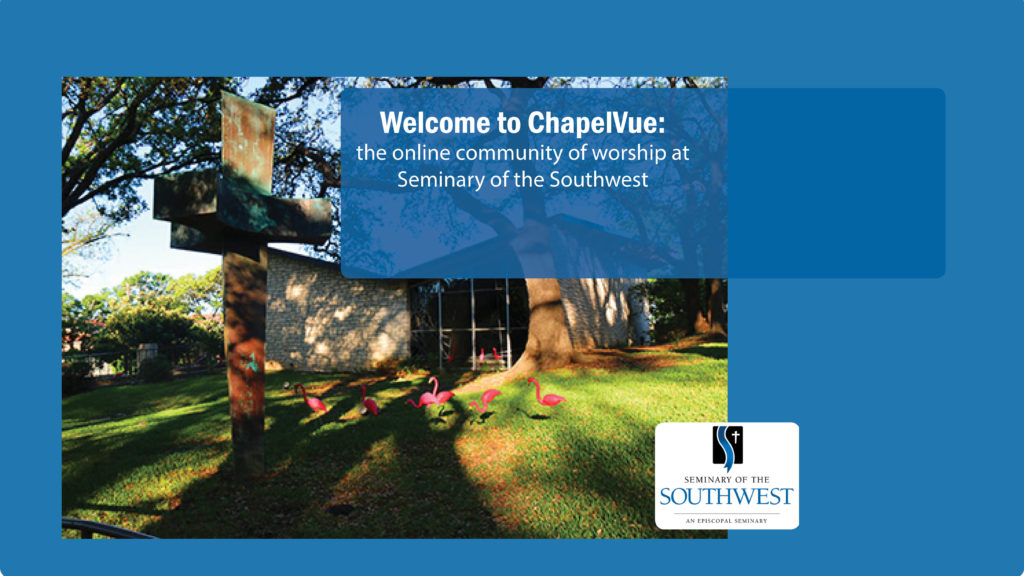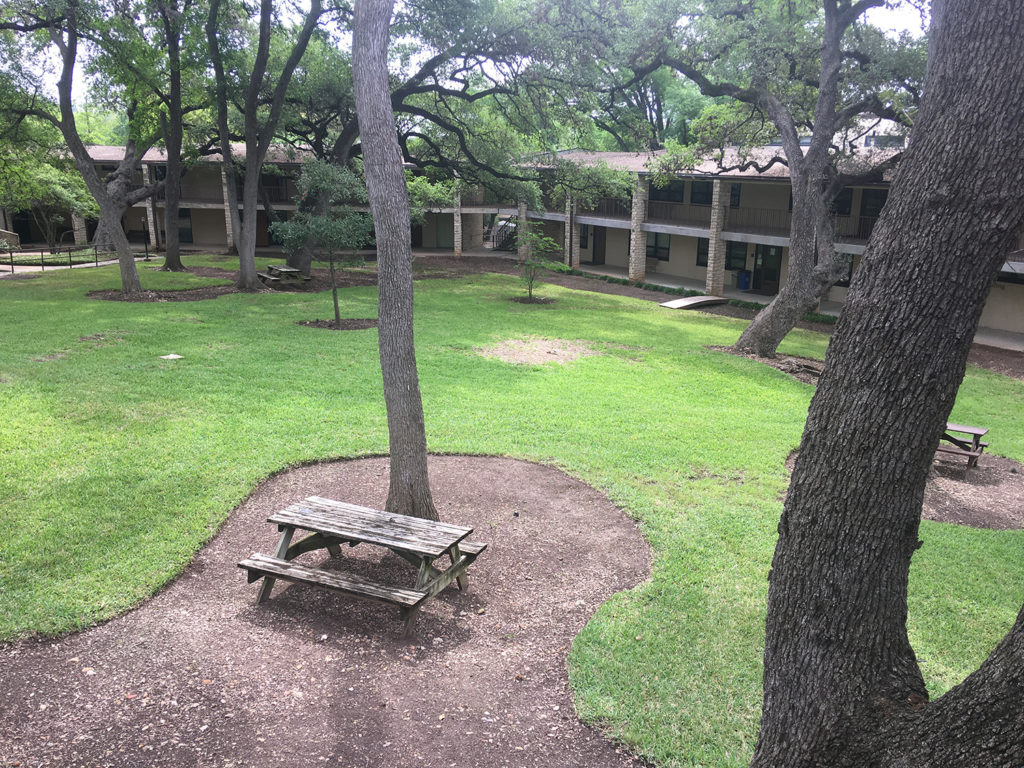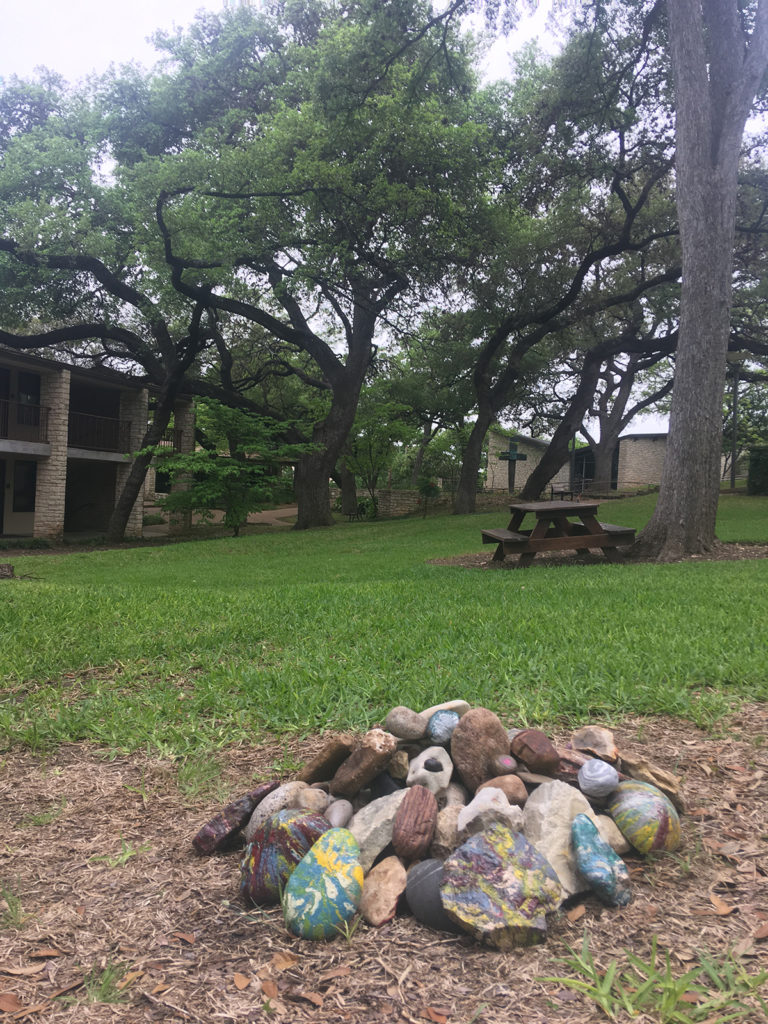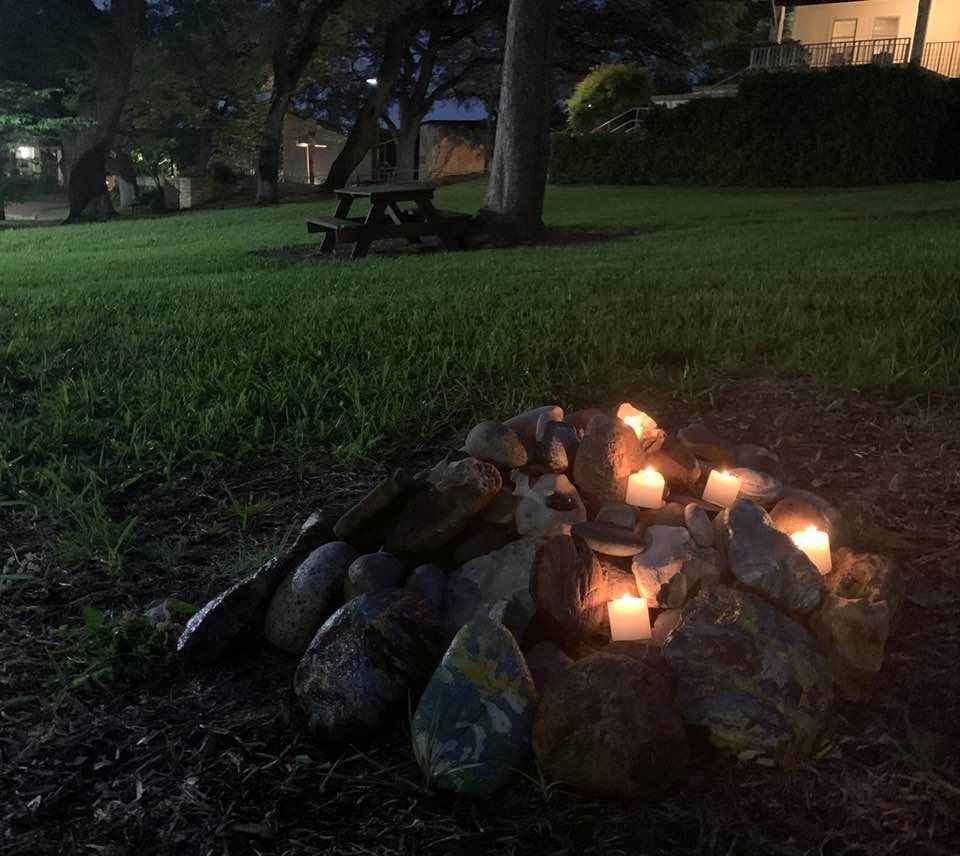Resilience, Creativity, and Determination Define the Last 30 Days for Southwest.
On March 13, 2020, with the pandemic crisis escalating rapidly across the nation and the world, Seminary of the Southwest joined most other institutions in the Austin area in closing all buildings on campus and entering into a stage of remote operation.
The week before, as the scale of the crisis was still unfolding, Dean Cynthia Briggs Kittredge had appointed a task force of key administrative and faculty leaders to help the seminary navigate what was to become a complicated and unprecedented challenge.
“Southwest is a community of creative problem solvers. At the time we had no idea how the situation would unfold, but it was clear we needed some structure in place to confront and solve new challenges nimbly and effectively. This is the team we needed,” said Kittredge.
Dean Kittredge recorded this message on March 13 immediately following the decision to move to remote operations.
Like most schools in the Austin area, the March 13th decision preceded the already scheduled week of Spring Break. In this short period of time, the faculty and staff developed and implemented plans for virtual classroom instruction and remote administrative operation. With the physical gathering of community no longer possible, this key characteristic of Southwest’s intentional formation model had to be re-imagined.
“In two weeks, this administration and faculty basically took apart this 67 year old institution and put it back together with different— and sometimes opposing– parts,” said Eric Scott, director of communication and marketing.
After Spring Break and a “transitional week” to test how classes, worship, and administration would operate on a virtual platform, Southwest officially resumed classes on Monday, March 30th. With multiple and differing challenges confronting each member of the Southwest community, they demonstrated one quality above all:
“Resilience. In the face of unimaginable challenges, every member of this community has been inspirationally resilient. We are all separated right now, some by great distances, some by apartment walls, but I have seen persistence and determination to hold on to our most beloved asset – each other,” said Kittredge.
In those two weeks, faculty members cancelled spring break plans and worked tirelessly to rework syllabi and curricula – and learn a new and unfamiliar skill to some: hosting classes on the Zoom meeting platform. The supportive and collaborative nature of the Southwest learning community became evident.
“It’s stressful to have a semester of learning interrupted and suddenly be forced to pivot. But this community is inspiring; we’re looking out for each other, experimenting, laughing whenever possible, crying with and comforting one another. And we’re watchful for what the Spirit of God is doing in our midst, in us and through us, during this time of uncertainty,” said Dr. Gena Minnix, Director of the Loise Henderson Wessendorff Center for Christian Ministry and Vocation and Associate Professor of Counselor Education.
The pivot for students was equally challenging. With many practicing social distancing in their College Court apartment, it was clear that beloved traditions, both in the church overall and at Southwest specifically, were going to be different this year. “I canceled my spring break travel, and have been pretty much confined to my College Court apartment — which is a lot like living in a one-room log cabin. I was also devastated by the fact that we couldn’t celebrate Holy Week in Christ Chapel. Since I am head sacristan, this was supposed to be my responsibility. Instead of preparing our Christ Chapel services, I used the newfound free time to write liturgies for people to use at home, and have shared them with a number of parishes in different states, and with members of the Southwest community,” said MDiv Midder Barbara Gausewitz.
Gausewitz and the other Christ Chapel sacristans mobilized quickly to work with the seminary communications department to create a virtual version of one of the most sacred spaces on the Southwest campus, Christ Chapel. They committed to a routine of Noonday prayer Monday though Thursday, hosted on Zoom meetings, which they are recording and sharing broadly afterwards. “Routine is important in the life of a seminarian. And the welcoming nature of Christ Chapel to all who want to worship there is central to our community ethos. The sacristans felt it important to maintain both those qualities in some way. They’ve done an incredible job. The Episcopal Church is in outstanding hands with future priests like these,” said Scott.
The sacristans created ChapelVue, a website to host and support these Noonday prayer services by sharing the recordings of the services, as well as providing additional and inspirational content to enhance the experience of those joining in worship.

Students began efforts to support each other’s mental and physical well-being in the face of an unimaginable situation. MDiv middler Hume Jamison began hosting a daily socially distancing workout at College Court. MDiv middler Toni Belhu started organizing socially distancing walks. MDiv middler James Reiss reads Compline each evening on Facebook live from the diocese of Long Island. MDiv senior Luz Montes and her husband, Thanh, began sharing videos to Facebook of them singing hymns and other music important to the Southwest community. Creativity and music began to emerge as another important and common theme.
MDiv Middler Christine Brunson organized a ‘Hymn Sing’ for those in campus housing. “I decided to organize the Hymn Sing at our seminary housing after I saw a video of apartment residents in Italy singing from their balconies. Music is healing and singing familiar hymns as a community was so special. We maintained a lot of distance from each other throughout, and many people sang from their own balconies. It was especially nice to be able to livestream it to members of our community who could not be there. During my years at Seminary of the Southwest, I have learned a lot about the power of community and intentional living. Within this community, we learn to not only care for ourselves, but for each other. Music is a beautiful tool that we can use to do just that,” said Brunson.
Brunson and several students used Facebook live to share the Hymn Sing.
Some members of the student body were already traveling for Spring Break and remained where they were when the campus was closed. James Reiss was at home on Long Island, where he remains. “I traveled home to Long Island for Spring Break to find myself trapped in the northeast. Due to the stricter guidelines of the Stay-in-Place order in New York State, I decided to cancel my return flight to Austin and continue my studies up here for the foreseeable future. Being home near family is good; but I am socially distant from my mother and sister who are both nurses at hospitals. I am staying at a residence on church grounds at Trinity Episcopal, Northport. I’ve been keeping busy by attempting to walk everyday. As an extrovert, this social distancing is hard work. Seminary of the Southwest has been considerate and accommodating during this strange, new time. Faculty has put readings online, in addition to our Zoom classes. To maintain mental health, I’ve been renovating portions of the kitchen here at the residence. I’ve been staining cabinets and installing them in the walls; I can see why Jesus liked this whole carpenter thing. I have maintained contact with my community at Southwest by tuning in to Morning and Evening Prayer on occasion and talking to classmates outside of class time,” said Reiss.
Reiss also noted how this new physical reality brought with it some benefits for formation. “As a student, I feel like I am connecting more with the practical application aspect of all my classes. I’ve been designing Choral Morning Prayer liturgies with my home parish Rector, along with officiating Compline every night of the week (Liturgy II). I’ve been checking in on homebound parishioners and classmates, and listening to their concerns about this new age while attempting to maintain boundaries (Family Systems and Ethics II). At Compline each night, I offer a two-three minute reflection off the cuff around the readings of the day (Preaching without Notes). I have been figuring out how to broadcast Compline to my personal page, my home parish, and my field education parish. I do this in addition to attending my field ed parish’s virtual youth group three times a week and confirmation class (Practical Theology and Field Ed Colloquy). I am living into my classes; this is real life ministry,” shared Reiss.
Gausewitz has also experienced unexpected formational moments of growth. “With church and chapel both suspended, I’ve rediscovered the joy and richness of praying the Daily Office and reading scripture at home. There is nothing I can do about this pandemic except stay home and pray, and it has made me realize that I probably should have been doing more of that all along,” she said.
Soon after classes resumed and new routines were established, the community turned its attention to solving one of the many challenges presented by social distancing- how to observe Holy Week and the Triduum. Dean Kittredge brought to the community a plan (one endorsed by the Bishop of Texas, the Rt. Rev. C. Andrew Doyle, and the Presiding Bishop, the Most Rev. Michael Curry), which she called, “Improvisational Liturgy of the Resurrection.” In her announcement to the community, she described it like this:
“The basic elements of liturgy are time, space, people, and elements like bread, wine, water, oil. In the Triduum sacred time is primary. The Triduum enacts death, burial, and resurrection. Scriptural accounts of the passion highlight time – sabbath, evening, morning, place – particularly the tomb, (whether in a garden or not).”
At the center of of Southwest’s tree covered campus is an open green space that seminarians refer to as the Motte.
“The Motte is a sacred space on the seminary campus. It has taken on new poignancy and urgency as the buildings, including the chapel, are closed. People spontaneously gather there even if they stay ten feet distant from one another,” added Kittredge.
Southwest’s “Improvisational Liturgy” began on Holy Friday and all day on Holy Saturday, as people in the Southwest community and beyond came to the Motte individually where they brought a stone that they had chosen and washed (“As the altar is washed at the end of the Holy Thursday liturgy,” reminded Kittredge) to a place in the Motte.
“We weren’t sure people would know exactly where in the Motte to begin this, so on Friday morning I went down to place the first stone. As is usual this time of year the Motte was lush and green and wonderfully maintained by our dedicated maintenance team. But there was one barren, flat, and slightly elevated spot. The Motte had revealed to us where this was to happen,” said Kittredge.

Over the course of the two days a small but meaningful gathering of stones grew. Some were painted, some wrapped in ribbon, some in their natural form. What was quickly clear about the growing cairn: it was precious. “People came and offered prayers or actions or songs or silence,” said Kittredge, who visited the site often. “Single visits to the place continued over the period of days until there was this pile of stones. A tomb. A grave. A tower. A temple.”


Then beginning at before dawn on Sunday morning, people began the second part of the ‘improvised liturgy’ – to return and take away their stones, one by one. “When the sun is high, the grave is empty, the tower is gone, and the temple is the community of the risen Christ,” said Kittredge.
The 3 day practice was well documented on Southwest’s social media pages.
Unsurprisingly, the Southwest community has rallied around these expressions of faith and creativity, as well as rallying around each other. “I’ve felt really touched by how quickly and decisively Dean Kittredge and Academic Dean Bader-Saye responded to this crisis. The safety and well-being of our community and neighbors are their priority; their communication with students, faculty, and staff is calm, optimistic, compassionate, and good humored,” said Minnix.
MDiv Senior Lucy Strandlund added, “Seminary leadership has been wonderful about being in touch with us, keeping us updated, and checking on everyone. I experience a strong sense of community at the seminary among both students and staff, even when we can’t be together in person.”
While at the time of this writing, the Austin area has a stay home order in effect until May 8th, the administration made the decision to commit to remote operation and virtual classrooms until the end of the semester. This meant joining most other seminaries and colleges across the nation in cancelling the traditional commencement exercises and planning to celebrate virtually.
“These four weeks have not been easy. Its end is not certain. I do know that I will remember forever how the community collaborated so wonderfully in the face of adversity. We are an institution built to form spiritual healers, and these healers— whether priests, counselors, chaplains or spiritual directors — will be needed more than ever in the world that is revealed after the pandemic,” said Kittredge. “This school will emerge a new place. It will be better. It will be of God.”


